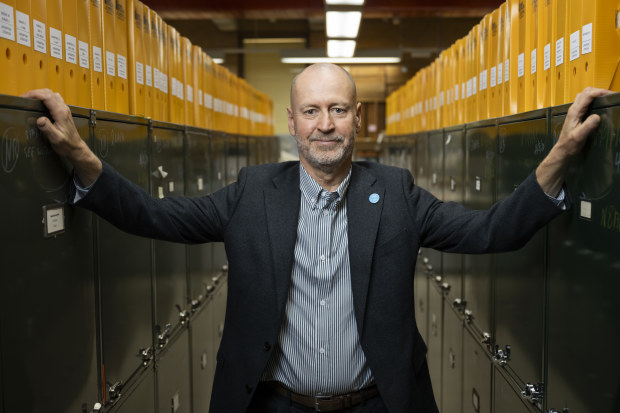Big ideas trump commercialisation for new CSIRO boss

The new boss of the CSIRO says cutting-edge science must help smaller businesses improve their profitability and productivity, and that commercialisation should no longer be the main goal of the national science agency.
In contrast to his predecessor, Silicon Valley veteran Larry Marshall, whose tenure focused on turning the brightest ideas from Australian minds into commercial realities, newly appointed chief executive Doug Hilton said CSIRO should not be just about picking winners.

Doug Hilton says CSIRO is on hand to provide the research help tackle Australia’s toughest challenges. Martin Ollman
In his first interview since being appointed to lead the body, Dr Hilton said he wanted to build closer ties with the private sector and highlighted the agency’s contribution to international research missions.
“We provide amazing support to NASA in a whole lot of missions. So it’s a fantastic impact, but it’s not a commercial pathway,” Dr Hilton said.
“CSIRO is a big enough organisation that we can use all the pathways to impact rather than focusing or emphasising one particular path.”
Dr Hilton spent his first official day on the job visiting the Dish – the Parkes radio telescope officially named Murriyang – after a solo camping trip across central and south-east Queensland.
Any nerves the Parkes staff may have had about meeting their new boss would have evaporated when they met him the night before at the local pub, unshaven and “a bit grubby” after spending three weeks in national parks.
Dr Hilton, who is a molecular and cellular biologist, said Murriyang was an iconic representation of Australians’ contribution to science.
“I found the idea that this little slice of the world that we occupy as a nation is so crucial to space research really inspiring,” he said.
The early days of Dr Marshall’s tenure included a culture clash, as the former CEO brought a Silicon Valley style focus that included the introduction of new CSIRO-funded venture capital operations.
Main Sequence Ventures has since raised three funds, with more than $1 billion funds under management, and Dr Hilton said he had instructed its partners to make big bets on founding and funding new companies.
“I want them to take risks, choosing smart ideas, with passionate people and developing SMEs that are going to make a difference in our lives, but also going to create the jobs of the future,” he said.

Doug Hilton spent his first day on the job visiting the Parkes radio telescope, Murriyang, also known as the Dish.
However, away from the commercial cut and thrust, Dr Hilton said CSIRO scientists had an important role to play in showing Australians that big problems could be tackled.
He cited industry transition to net-zero, protecting the country’s biodiversity, and having sovereign capabilities such as vaccine production as examples.
“I’m really interested in helping the private sector, irrespective of the size, embrace research and see it as a really important part of their company’s sustainability, profitability and productivity,” he said.
“We are here to do the research that helps and equips Australia to deal with the challenges that confront us as a country.”
Dr Hilton has spent his career – aside from a few years in the early 1990s working at the Massachusetts Institute of Technology – at Melbourne’s Walter and Eliza Hall Institute of Medical Research, which he joined as a university student in the mid-80s.
As director of WEHI since 2009, his medical research focused on understanding how blood cells communicate. He used this knowledge to improve treatment of diseases like asthma.
In 2018, Dr Hilton opened an on-site childcare centre at the institute, allowing staff to transition back into research after having children, something he wished he had done much earlier in his tenure.
“I think scientists are at their most brilliant and creative when they are young,” he said. “Anything we can do to allow them to flourish personally will be good for their science.”
Introducing your Newsfeed
Follow the topics, people and companies that matter to you.
Find out moreRead More
Latest In Technology
Fetching latest articles